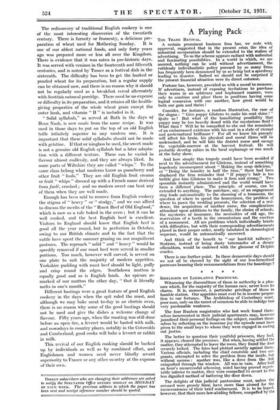English Cookery
BY F. Want.
TO pit French cuisine against English cookery in a battle for supremacy is quite unnecessary. For there is room in the world for both, and both schools of cookery are equally good in their own way. When the Revolution of 1848 had caused the leading French chefs to try their luck in England, Count D'Orsay wrote from Paris in 1852: " You arc now au fait with the pretended gastronomy. It has emigrated to England and has no wish to return. We do not absolutely die of hunger here; and that is all that can be said." Thus in England French cookery became the fashion. The education of girls on the same lines as boys, cheap travel, snobbery and the fact that domestic servants arc not eligible for unemploy- ment benefit, have done their part in damaging England's fine old traditional cookery until the art and craft were nearly lost, but not quite. No epicure, however fastidious, could fail to be pleased with some traditional English delicacies. Take, for example, Stilton cheese, with its romantic history beginning at Quenby and the Bell Inn. ' on the Great North Road : and when served as " Potted Stilton," no savoury is lighter or more delicate. Or take the leavened oatcake or riddle bread of the West Riding of Yorkshire. These are " delicacies," and yet one of the charges brought against English cooking is that it is not light enough for modern tastes. We have had the " Roast Beef of Old England " dinned into us in season and out of season, but even roast beef can be a' delicacy if the portions served arc delicately carved and not too large. The rediscovery of traditional English cookery is one of the most interesting discoveries of the twentieth century. There is furmity or frumenty, a delicious pre- paration of wheat used for Mothering Sunday. It is one of our oldest national foods, and only forty years ago was prepared more or less all over the Kingdom. There is evidence that it was eaten in pre-historic days. It was served with venison in the fourteenth and fifteenth centuries, and is noted by 'Risser as a festival dish in the sixteenth. The difficulty has been to get the husked or pearled wheat for its preparation, but a regular supply can be obtained now, and there is no reason why it should not be regularly used as a breakfast cereal alternately with Scottish oatmeal porridge. There need be no expense or difficulty in its preparation, and it retains all the health giving properties of the whole wheat grain except the outer husk, and vitamin " B " is included in it.
" Solid syllabub," as served at Bath in the days of Beau Nash, is now made from the same recipe. It was used in those days to put on the top of an old English trifle infinitely superior to any modern one. It is important that these solid syllabubs should not be made with gelatine. If that or isinglass be used, the sweet made is not a genuine old English syllabub but a later adapta- tion with a different texture. These can be varied in flavour almost endlessly, and they are always liked. In some parts of Wiltshire they are called " whips." To the same class belong what modems know as gooseberry and other fruit " fools." They are old English fruit creams or fruit " whips " dressed up with a French name derived from Joule, crushed ; and no modern sweet can beat any of them when they are well made.
Enough has been said to remove from English cookery the stigma of " heavy " or " stodgy," and we can afford to discuss the merits of the "Roast Beef of Old England," which is now as a rule baked in the oven ; but it can be well cooked, and the best English beef is excellent. Visitors to England should know that English beef is good all the year round, but in perfection in October, owing to our British climate and to the fact that the cattle have spent the summer grazing on our magnificent pastures. The reproach " solid " and " heavy " would be speedily removed if our roast beef were served in smaller portions. Too much, however well carved, is served on one plate to suit the majority of modem appetites. Yorkshire pudding with roast beef should be light, puffy and crisp round the edges. Southdown mutton is equally good and so is English lamb. An epicure re- marked of our mutton the other day, " that it literally melts in one's mouth."
Different bastings were a great feature of good English cookery in the days when the spit ruled the roast, and although we may bake meat to-day in an electric oven, there is no reason why some of the good bastings should not be used and give the dishes a welcome change of flavour. Fifty years ago, when the roasting was still done before an open fire, a leveret would be basted with milk, and nowadays in country places, notably in the Cotswolds and Cumberland, good cooks will bake a leveret or rabbit in milk.
This revival of our English cooking should be backed up by individuals as well as by combined effort, and Englishmen and women need never blindly award superiority to France or any other wintry at the expense of their own.















































 Previous page
Previous page